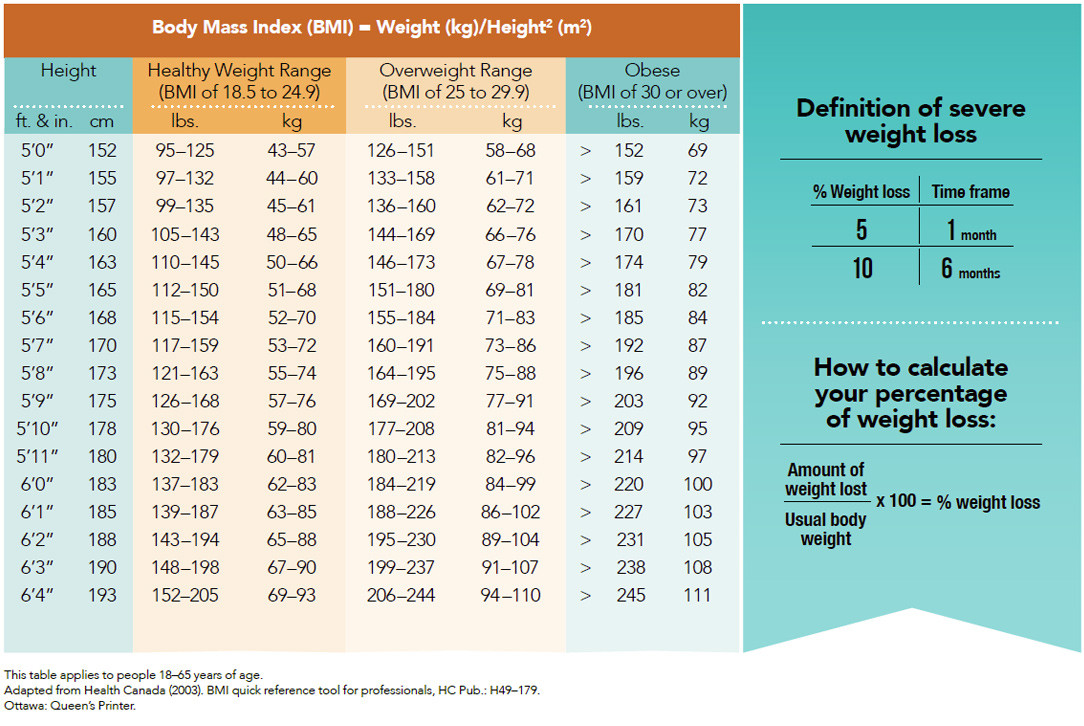
Most people associate cancer or its treatment with weight loss but weight gain can also occur. There are ways to cope.
What is a healthy weight?
A healthy weight is based on your “Body Mass Index” or BMI. A BMI between 18.5 and 24.9 is considered in the healthy range and is associated with the lowest risk of developing health issues. A BMI over 24.9 (overweight) or 29.9 (obese) are both linked to increased health risk. See the table below to determine your BMI.
Your waist circumference can also be used to estimate your health risk. Too much weight around the waistline is linked to a higher risk of several chronic diseases including heart disease, diabetes and some cancers. A healthy waist size for women is a size below 35 inches (88 cm). A mans’ waist should not exceed 40 inches (102 cm).
What causes unplanned weight loss?
Weight loss is a common side effect of cancers of the lung, head and neck and digestive tract (e.g. esophagus, stomach, pancreas, liver). Up to 40% of patients experience weight loss prior to their cancer diagnosis and 40% to 80% are expected to become malnourished at some point in their treatment.
Most of the time, weight loss occurs from eating less than usual. Loss of appetite or desire to eat is typically present at diagnosis in 15% to 25% of all people with cancer and may also be the result of treatment side effects.
When should I be concerned about my weight loss?
The amount of weight you lose and how fast you lose it is important, even if you have weight to spare at the start. Significant weight loss in a short period can be critical. Rapid weight loss can weaken the immune system, impair healing and limit your ability to perform daily activities.
Severe weight loss is often defined as a 10% decrease in your usual weight in less than 6 months or a 5% decrease in your usual weight in less than 1 month.
Winning a losing battle
You can prevent or slow down unplanned weight loss. The first step is to manage side effects caused by the cancer or its treatment. When nausea, constipation, taste changes, diarrhea, dry mouth and pain are well controlled, it will be easier to eat. Discuss these symptoms with your healthcare team. The second step is to make “every bite and sip count” so that you are getting the most energy and nutrients from what you eat and drink.
Not all weight is created equal
Muscle mass often decreases with weight loss. Loss of muscle tissue is more common and occurs at a much faster rate in people with cancer who are receiving treatment than in healthy individuals who are on a “weight loss program.”
Muscle loss leads to increased fatigue, decreased strength and overall de-conditioning which can be very distressing. Recent research shows that loss of muscle tissue may also result in more toxic side effects from chemotherapy and worsen survival in some individuals.
Tips to reduce muscle loss
• Eat a balanced diet (follow our Guide to Healthy Eating)
• Include good sources of protein
• Prevent rapid weight changes, if possible
• Exercise regularly – even 10 minutes of walking helps
Unwanted weight gain
Weight gain is a common side effect of breast, prostate, colon and rectum, uterus and brain cancers. The reason for this weight gain is unclear, but likely related to many factors including the cancer and/or its treatment.
Being overweight and obese can impact your quality of life and can also increase the risk of cancer recurrence and reduce survival. If possible, preventing weight gain (especially if you are overweight) is the first step. Use the BMI ranges to determine if your current weight puts you at any health risk. If your weight has increased, but you are still within the healthy weight range, there is less reason for concern. Speak to your dietitian if you have any questions or concerns about your weight.
If I am overweight, is it okay to tryto lose weight during treatment?
If you are coping well with few side effects or these are well controlled, you may be able to make lifestyle changes that encourage weight loss while undergoing cancer treatment. For others, waiting until after treatment may be the right decision. Discuss options with your cancer doctor and/or dietitian.
If you need to lose weight, a safe rate of weight loss is 1–2 lbs. (0.5–1 kg) per week. The most effective way to lose weight is to balance the number of calories youconsume with your physical activity level. Over time, eating fewer calories than you need, will result in weight loss. Despite the popularity of fad diets, the most important factor when it comes to weight loss is the number of calories consumed. Keeping physically active will help to spare muscle and maintain weight loss over the long term.
Balancing the scales
Keeping track of your weight during and after cancer treatment is important. Weigh yourself every week so that weight loss or gain can be caught early and addressed without delay.
References
Ollenschläger et al. (1991). Tumor anorexia: causes, assessment, treatment. In Supportive Care in Cancer Patients II (pp. 249–259). Berlin, Germany: Springer Heidelberg. Lesser et al., (eds), (2013). Oncology nutrition for clinical practice. Chicago, IL: Oncology Nutrition Dietetic Practice Group of the Academy of Nutrition and Dietetics. Rock et al., (2012). American Cancer Society guidelines on nutrition and physical activity for cancer survivors. CA: A Cancer Journal for Clinicians, 62(4), 242–274.



Comments are closed.